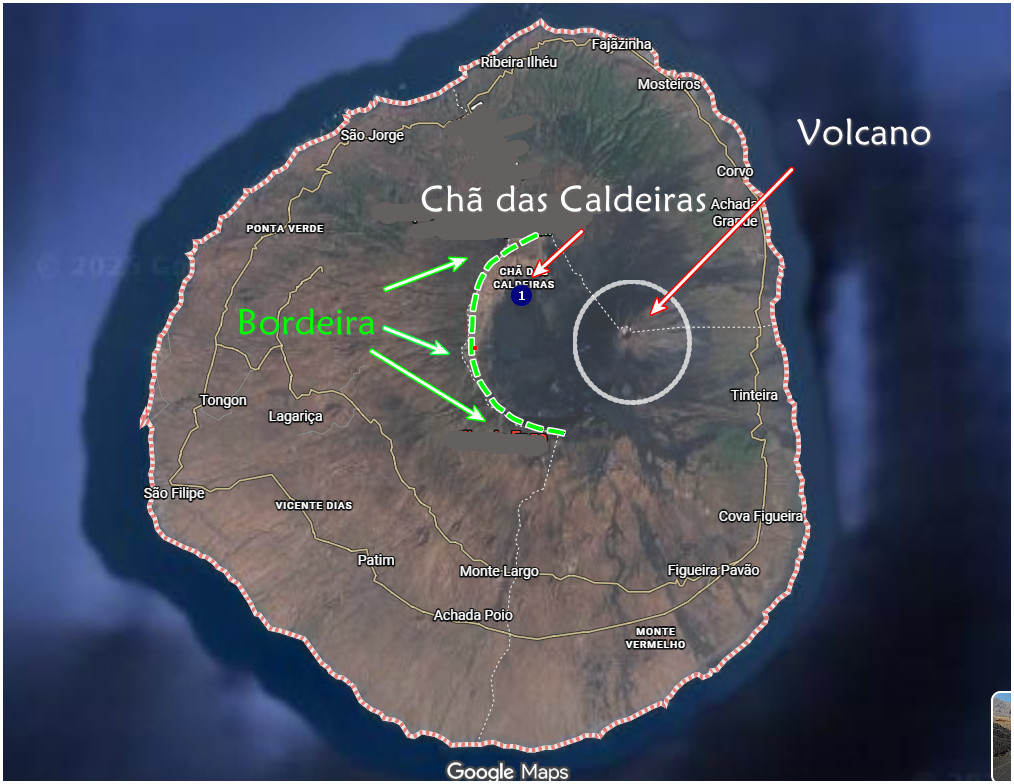
Fogo island volcano
Pico do Fogo, Cape Verde's Highest Peak
The island of Fogo, whose very name means "Fire," is the geological and spiritual heart of the Cape Verde archipelago. Its paramount feature, the Pico do Fogo (Peak of Fire), is an active stratovolcano that dominates the entire island.2 At an impressive 2,829 meters, it is the highest point in all of Cabo Verde and one of the steepest volcanoes in the Atlantic.3
Cape Verde's Volcanic Heartbeat: Fogo Natural Park
The colossal geological feature is protected as the Fogo Natural Park (PNF), established in 2003.4 Spanning over 8,468 hectares, the park covers nearly 80% of the island and is the core of the recently designated Fogo UNESCO Biosphere Reserve.5 It is a dynamic, active volcanic laboratory where you can literally sleep inside a volcano crater.6
The park's topography is defined by the colossal summit caldera—the Chã das Caldeiras, a vast, 40 km² depression enclosed by the dramatic, near-vertical cliff face known as the Bordeira, which can reach up to 1,000 meters in height. This stark, moon-like terrain is the park's centerpiece, offering a visceral understanding of immense geological forces.

History and Geology: A Living Laboratory
Fogo is the archipelago's only active volcano, with a history of approximately 30 recorded eruptions since the islands were settled in 1460, occurring on average every 19.2 years.
The Catastrophic 2014–2015 Eruption
The most recent and defining event began on November 23, 2014, and lasted 88 days. Lava flows—displaying both the smoother pahoehoe and the rougher aa types—destroyed extensive agricultural land and tragically buried the two main communities within the caldera, Portela and Bangaeira. The destruction included the newly built park headquarters, all 14 accommodation establishments, and the main access road, resulting in an economic toll of approximately $30 million.
Today, the park acts as a live geological textbook. Visitors can walk on the young craters, like Pico Novo (formed in 2014) and Pico Pequeno (formed in 1995), observe active fumaroles, and distinguish between the two distinct types of solidified lava, a testament to the ongoing evolution of the landscape.
Life from Fire: Biodiversity and Endemism
Despite the harsh environment, the park harbors surprising biodiversity.7 The high-altitude terrain creates microclimates that support a variety of flora and fauna, including:
Endemic Plants: Scientists have recorded 37 endemic plant species here. Most notably, the critically endangered Volcanic Wallflower (Erysimum caboverdeanum) and the striking Fire Thistle (Echium vulcanorum)8 thrive in the ash and scoria of the crater rim.
Fauna: The park is an Important Bird and Biodiversity Area, home to species like Alexander's Kestrel (Falco alexandri) and the Cape Verde Sparrow.
The Unbreakable Spirit: Living with the Volcano
The defining characteristic of Fogo is the unbreakable resilience of its people. Despite the comprehensive destruction, residents consistently return to Chã das Caldeiras to rebuild, fueled by the unique agricultural opportunities and a deep, ancestral cultural attachment.9
The government implemented a "Light Footprint" approach for recovery, prohibiting permanent housing and restricting urban expansion in the high-hazard area. This policy ensures the community can maintain its life and culture within the caldera while minimizing future risk. To visit is to witness a community living in profound, dynamic harmony with nature's rawest power.
Hiking in Fogo island
Fogo Natural Park is the island's premier attraction, drawing adventure travelers, volcano enthusiasts, and nature lovers from around the world.
The Ultimate Volcano Hike
The ascent of Pico do Fogo is the ultimate Fogo experience:
Route: The 8.2 km round trip starts in Chã das Caldeiras, gaining over 1,000 vertical meters. The ascent takes 4–6 hours (Difficult Level).
The Descent Hack: The fastest, most memorable part is ash surfing—running or sliding down the deep, soft volcanic ash/scree slopes in 90 minutes or less.
Safety: A local, certified guide (costing €25–50) is mandatory for the summit climb due to the steep, unstable terrain and potential for sudden weather or geological changes.
The Agricultural Miracle: Vinho do Fogo
The volcanic earth is extremely fertile, giving rise to unique products. The Agricultural Miracle of Fogo has led to global recognition:
Fogo Wine (Vinho do Fogo): Cultivated in high-altitude vineyards (up to 1,800m), this "Lava Wine" (red, white, rosé) boasts a powerful flavor and high alcohol content, influenced by the volcanic terroir. Wine tasting in the local cellars is a key activity.10
Fogo Coffee: Grown on the cooler northern slopes, the high-altitude Arabica beans are renowned for their unique, quality aroma.
Other Delicacies: The fertile soil supports orchards of apples, peaches, and quince, alongside the creamy, salty-spicy goat milk cheese.
Beyond the Caldera: Practical Information
The park offers alternative, shorter hikes, such as the 2–3 hour circuit around the younger craters, where the ground remains noticeably warm in places. For a longer adventure, the descent hike from the caldera down to the coastal village of Mosteiros showcases the dramatic transition from barren volcanic landscape to lush tropical greenery.
Access: The primary access is via the road from São Filipe to Chã das Caldeiras, a dramatic 45-60 minute drive. Shared taxis (aluguers) are the most common transport.
Accommodation: Staying within the park, particularly in rebuilt guesthouses like Casa Marisa or Casa Mariza 2.0, offers an immersive experience, allowing you to sleep inside the crater under star-filled skies.
Best Time to Visit: The dry season from November through June offers the most stable weather and clear skies for summit attempts.
Fogo Natural Park is more than a protected area—it is the pulsing heart of Cape Verde, offering the challenge of a lifetime for hikers and an unforgettable lesson in nature's power and humanity's enduring spirit.
